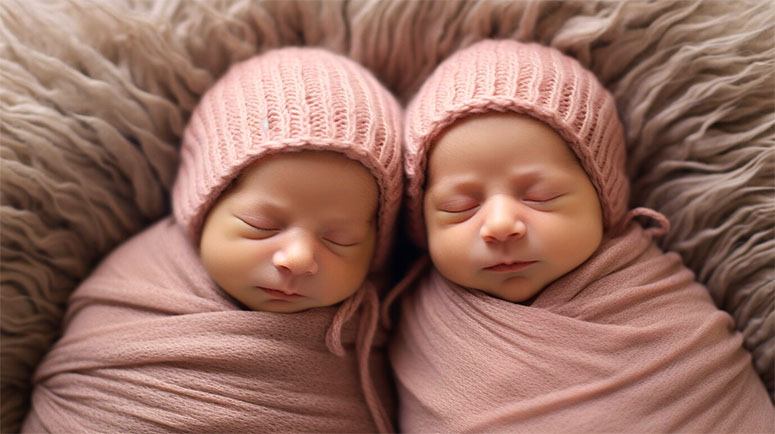Contents
Identical twins have long captivated researchers and the public alike with their unique bond and the complexities surrounding their formation.
This article examines the science behind identical twins, detailing the process of their formation, the statistical probabilities of their occurrence – including the question of what are the odds of having identical twins – and the various factors that may influence their likelihood.
Additionally, it addresses the potential risks associated with pregnancies involving identical twins, as well as the unexpected benefits that may arise from such circumstances.
The article also highlights several notable identical twins who have garnered widespread attention.
We invite you to explore the fascinating realm of identical twins.
What are identical twins?
Identical twins, scientifically referred to as monozygotic twins, represent a unique phenomenon in human reproduction characterized by the division of a single fertilized ovum into two embryos, leading to the formation of two genetically identical individuals.
This process is influenced by a range of genetic factors and carries significant implications for twin statistics and classifications.
The emergence of identical twins prompts intriguing inquiries into genetics and the influence of familial history on twin formation, as well as the social ramifications associated with having identical siblings.
How are identical twins formed?
Identical twins are created through a remarkable biological process known as embryo splitting, which takes place when a single fertilized ovum undergoes zygotic division shortly after conception.
This process may be influenced by several factors, including maternal health, ovulation cycles, and reproductive health considerations, all of which play crucial roles in twin gestation and the probability of multiple births.
What are the odds of having identical twins?

The likelihood of conceiving identical twins, while comparatively lower than that of fraternal twins, presents a compelling area of inquiry within the fields of twin statistics and reproductive genetics.
Recent research estimates the occurrence rate of monozygotic twins to be approximately 3 to 4 per 1,000 births.
This rate is influenced by factors such as heritability, maternal age, and a range of environmental variables that may impact the probability of twinning.
What factors affect the likelihood of having identical twins?
Several factors significantly influence the likelihood of conceiving identical twins, with genetic predisposition, maternal age, and fertility treatments being among the most important.
Research has demonstrated that women over the age of 30 or those undergoing fertility treatments, such as in vitro fertilization (IVF) and ovulation induction, may have an increased probability of having twins due to biological responses and genetic factors.
The genetic composition is a critical determinant of twin births, as families with a history of twins often exhibit higher rates of multiple births.
Additionally, ethnicity can impact twin rates, as certain populations display a naturally higher incidence of multiple births.
Furthermore, lifestyle choices and overall health can influence reproductive outcomes, highlighting the complex interplay of biological and environmental factors in the multifaceted process of conception.
A comprehensive understanding of these elements is essential for prospective parents considering the possibility of having twins.
Can identical twins be predicted?
The prediction of identical twins is a multifaceted subject that involves the integration of genetic testing, family planning, and findings from twin studies.
Although there is no definitive method for predicting identical twinning, an understanding of family history, coupled with reproductive health assessments, can provide valuable insights into the likelihood of conceiving twins, especially in families with a history of monozygotic twinning.
What are some methods for predicting identical twins?
Methods for predicting the likelihood of having identical twins include genetic counseling and fertility awareness, which provide valuable insights into family patterns and reproductive choices.
Through a meticulous analysis of genetic factors, healthcare professionals can offer recommendations or assessments regarding the probabilities of twinning, although precise predictions remain challenging.
These methods employ comprehensive family health histories and genetic markers to identify traits that may predispose individuals to conceive twins.
Additionally, advancements in reproductive technologies, such as in vitro fertilization (IVF), can significantly influence the chances of twinning, given that they often involve the transfer of multiple embryos.
Moreover, factors such as lifestyle choices, maternal age, and dietary habits can also play a substantial role in determining the likelihood of having identical twins.
Understanding these various factors can give the power to prospective parents to make informed decisions and anticipate the possibilities concerning multiple births.
What are the risks associated with identical twins?
Identical twins, while extraordinary, present a range of risks associated with twin pregnancies that underscore the significance of comprehensive prenatal care and maternal health.
These risks may encompass complications during pregnancy, including preterm labor, an increased likelihood of gestational diabetes, and difficulties during the delivery of twins.
Therefore, meticulous monitoring is essential to ensure favorable outcomes for both the mother and the infants.
1. Higher risk of complications during pregnancy
Identical twins are associated with an elevated risk of complications during pregnancy, which can have significant implications for maternal health and gestational age.
Factors such as increased physiological strain on the mother’s body may result in conditions such as preeclampsia and intrauterine growth restriction, thereby necessitating diligent prenatal care.
Considering these heightened risks, it is imperative for healthcare providers to closely monitor the mother’s health through regular screenings and assessments.
Complications may also include twin-to-twin transfusion syndrome, which can result in uneven growth and other critical challenges for the fetuses.
Consequently, establishing a strong relationship with an obstetrician who is knowledgeable about multiple gestations is essential.
Consistent ultrasounds and blood pressure monitoring can facilitate the early identification of potential issues, allowing for timely interventions that protect both maternal and fetal well-being.
This proactive approach can significantly influence the outcomes of pregnancies involving identical twins.
2. Increased chance of genetic disorders
The presence of identical twins is associated with an increased likelihood of genetic disorders, which may arise from various factors, including maternal nutrition and genetic predisposition.
Genetic counseling serves a critical role in assessing risks and preparing families for the potential challenges associated with raising twins.
The prenatal environment has a significant impact on the health and development of identical twins, making maternal nutrition an essential aspect of their well-being.
An adequate intake of key nutrients, such as folic acid, omega-3 fatty acids, and proteins, can help mitigate certain genetic risks and promote healthier outcomes.
Furthermore, genetic testing and personalized counseling can provide expectant parents with vital information regarding possible hereditary conditions.
By understanding their unique genetic makeup and potential health challenges, families can make informed decisions, thereby ensuring that appropriate support systems and intervention plans are established for the twins as they grow.
Are there any benefits to having identical twins?

The presence of identical twins offers distinct advantages that extend beyond the joys of parenting. These twins frequently develop a profound sibling bond that promotes companionship and emotional support.
The dynamics inherent to twin relationships can result in unique parenting experiences and benefits, significantly influencing the identities and interactions of the twins in meaningful ways.
1. Built-in best friend
Identical twins frequently experience a unique and inherently supportive companionship, providing one another with emotional support throughout their lives.
This sibling relationship fosters distinctive dynamics that can positively influence their development and social interactions.
The close bond shared between identical twins can lead to enhanced emotional well-being, as they typically possess a profound understanding of each other’s feelings and experiences.
This inherent companionship promotes improved communication skills, enabling them to articulate their thoughts and emotions more effectively, both with one another and in broader social contexts.
The shared experiences and challenges they encounter together contribute to the development of resilience and empathy—traits that are advantageous for cultivating strong relationships beyond their twinship.
Consequently, this exceptional connection can establish a foundation for a rich and emotionally intelligent future, allowing them to navigate life’s challenges with a supportive ally by their side.
2. Stronger bond with siblings
The bond between identical twins is frequently stronger than that of typical siblings, resulting in unique sibling dynamics that can significantly impact childhood development.
This close relationship can enhance social skills and provide better psychological support throughout their lives.
The psychological factors contributing to this exceptional connection include shared experiences and an inherent understanding of one another, which fosters a secure attachment that is often lacking in other sibling relationships.
As these twins navigate the complexities of early social interactions, the empathy developed between them often exceeds that of their peers.
This profound connection can also influence their relationships with others, as they may demonstrate preferences for companionship and communication styles that reflect their twin bond.
Moreover, the experiences they share can serve as a safety net during challenging life stages, allowing them to confront adversity alongside a partner who innately comprehends their emotions and needs.
3. Unique parenting experience
Parenting identical twins presents a unique experience that challenges conventional parenting styles, as it requires parents to navigate the complexities of raising two identical children who often display both shared and distinct personalities.
This journey offers rich opportunities for family bonding and insights into developmental psychology.
Each child may develop at their own pace, necessitating that caregivers adapt their approaches to meet individual needs while promoting both cooperation and independence.
The challenges are numerous – from addressing potential rivalry to facilitating their unique interests, parents frequently find themselves judiciously balancing their time and attention.
As they learn to appreciate the differences between their twins, parents also witness the profound rewards of observing a special bond develop.
Nurturing this connection fosters empathy and social skills while simultaneously creating lasting memories that underscore the joys of parenting two children who share similar genetic traits yet embody distinct characters.
What are some famous cases of identical twins?

Noteworthy cases of identical twins have garnered significant public interest and prompted extensive research on twin studies, yielding valuable insights into twin culture and the profound connections shared among these distinctive individuals.
From historical figures to contemporary celebrities, the narratives surrounding identical twins frequently underscore their compelling dynamics and the influence they exert on society.
1. The dionne quintuplets
The Dionne Quintuplets emerged as a significant cultural phenomenon in the 1930s, attracting substantial media attention and igniting discussions on multiple births and twin studies that remain relevant today.
Their narrative exemplifies both the fascination and the challenges associated with identical twinning.
These young sisters, born in Ontario, Canada, not only captured the hearts and imaginations of the public but also brought to light the medical and ethical complexities surrounding the care and commercialization of multiple births.
As the first documented set of quintuplets to survive infancy, their existence sparked debates regarding the management of birth announcements, parental rights, and the state’s responsibilities in their upbringing.
This unique historical context transformed societal perceptions, as observers began to regard multiple births not merely as scientific curiosities, but as human stories imbued with emotional depth.
Consequently, the Dionne Quintuplets have shaped a lasting legacy in discussions about family dynamics, healthcare, and media ethics.
2. The winklevoss twins
The Winklevoss twins have gained recognition for their entrepreneurial endeavors and intricate social dynamics, notably as co-founders of Facebook and subsequently as successful investors in cryptocurrency.
Their journey exemplifies the distinct paths that identical twins can navigate while managing their shared identity.
These individuals not only share physical characteristics but also possess a profound bond, often functioning as both collaborators and competitors in their respective pursuits.
Their experiences underscore the significance of the interplay between competition and cooperation in driving innovation, particularly within the rapidly evolving technology and finance sectors.
By leveraging their complementary skills and unified vision, they have established a prominent presence in the cryptocurrency landscape, pushing boundaries and challenging prevailing norms.
This unique dynamic, inherent to their twinship, has enabled them to cultivate a culture of entrepreneurial spirit and resilience, positioning them as influential figures in discussions related to both business and technology.
3. The olsen twins
The Olsen twins achieved significant prominence in the entertainment industry, captivating audiences with their early performances in television and film, which contributed to the emergence of a distinctive twin culture that has influenced an entire generation.
Their dual career trajectory underscores the intricacies and advantages of growing up as identical twins in the public spotlight.
Beginning with their breakout role on the beloved sitcom “Full House,” the twins expanded their endeavors to include fashion and film production, thereby redefining what it means to be a successful sibling duo in Hollywood.
They adeptly navigated the challenges associated with early stardom, including intense media scrutiny and public expectations, while also demonstrating their entrepreneurial acumen by establishing brands that resonate with fans globally.
This strategic evolution has had a profound impact on the entertainment industry and has set a precedent for other twin celebrities.
The Olsen twins have emerged as icons of twin culture, reflecting both the allure and complexities inherent in sharing a professional career while striving to maintain their individual identities.
Check out our FAQ further down for insights into the probability of having identical twins.
Discover the compelling world of probabilities and unique events. Feed your curiosity and gain new insights by checking out our articles at WhatAreTheOddsOf.NET.



